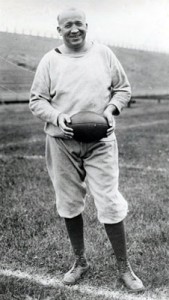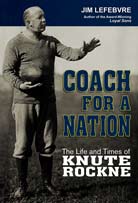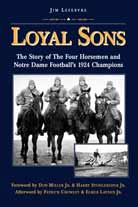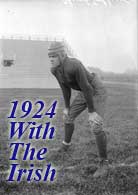It would be accurate to call Knute Rockne a “man on the move.”
After his playing days at Notre Dame (1910-13), he served as assistant coach to Jesse Harper in 1914-17, and kept his toe in the waters of competition beyond the college gridiron. Several times a week, after Notre Dame practice, he would zip across town to meet an aggregation of men playing under the aegis of the Muessel Brewing Company. And on many fall weekends, Rock would jump on an eastbound train and don the uniform of the semi-pro Massillon, Ohio, Tigers.
On a number of Saturdays, assistant coach Rockne was excused from the Notre Dame sideline to travel and scout an upcoming opponent. During each trip, he analyzed and digested strategy and psychology, how the game was played and how it was presented. He formulated his vision of what the game should look like, not just to those involved on the field of play and sidelines, but in the stands (and beyond).
Rock was always headed somewhere. Not with some grand plan, but more of a seat-of-the-pants compulsion to learn, do, speak, listen…move.
In the earliest years of the new century, football was marked by brutality and death. “Mass play” involved two groups of 11 brutes primarily smacking into one another, with small advances or retreats on each play. The emphasis was definitely on brawn, not brains. Partly necessitated by his own small stature, Rockne envisioned another type of game. Fluid, wide-open. Utilizing speed, deception, intelligence and imagination. In a sense, he would be transferring the qualities of a good track-man to the gridiron.
“Before you can defeat an opponent,” he would say, “you’ve got to out-think him.”
On offense, especially, that would mean quickness, feints and fakes, trying to create open space. Certainly, the effective pass play was part of this strategy – but only a part.
Unlike some stories that developed over the years, Rockne was quite modest about his contributions to how the game was played. He was quick to acknowledge those who came before him, saying on occasion, “All football comes from Yale” or “Everything I know came from Stagg.”
He was certainly at a vortex of a new game on November 1, 1913, when he first faked a limp, then burst into the open to corral a spiral pass thrown on an extreme arc by Gus Dorais. Their efforts at practicing pass routes on the sands of the beach at Cedar Point resort in Ohio that summer paid off dramatically in ND’s historic 35-13 thrashing of Army in the schools’ first meeting.
The pass had been around for several years since it was legalized in 1906. In those days, though, the fat, rugby-style ball was more likely to be tossed more-or-less on a straight line, to a stationary player. Dorais and Rockne broke new ground with their arcing throws and deceptive pass routes, respectively.
And while Nov. 1, 1913, was a defining moment in the history of football, Notre Dame – or any other school, for that matter – did not turn its offense into an “aerial circus” overnight. Over the next several seasons, Jess Harper, then Rockne starting in 1918, used the pass somewhat sparingly. But it was the constant threat of the pass that helped to open up the game.
Rockne’s other signature development was the backfield shift. Here, too, he was quick to note that all he had done was copied elements of Doc Williams’ Minnesota Shift, or Stagg’s Chicago Shift, and tweaked it some. Simply put, in the Notre Dame shift, all four backfield men would start in a diamond formation and turn it into a box. The center snap could go to any of the four men, who in turn might run through the line or around end, make a quick drop back to pass, attempt a quick kick if the situation was right. The possibilities were almost limitless, creating a nightmare for opposing defenses.
A key component of the Rockne vision was this: rather than play for a long drive which could eventually put the offense within striking distance of the end zone, Rock’s offense was designed to be a scoring threat from anywhere on the field, on any play. This was truly revolutionary, changing how the game was played…and viewed by the fans. Imagine sitting in the stands and watching your team execute play after simple play, many of them smashes into the line, hoping to garner the proverbial “three yards of dust” and eventually a first down. After enough of these, your lads might be in position for the final push over the goal line.
But with Rockne’s Irish, the dizzying motion of the players created flash and dash. And, with an end run or a quick pass, a long gain, even a touchdown, was a possibility on every play. A game that could be followed more easily from the stands, he reasoned, would attract more fans. He advocated for numerals on players’ jerseys and contrasting colors.
Fans paid attention. And by extension, so did the nation. Newspapermen wrote of the “genius coach” and his “wonder team.” And, more and more, that coach and his team was heading out to win over fans everywhere.
(For the full story on the life of Rockne, watch for Coach For A Nation: The Life and Times of Knute Rockne, available this September from Great Day Press.)







